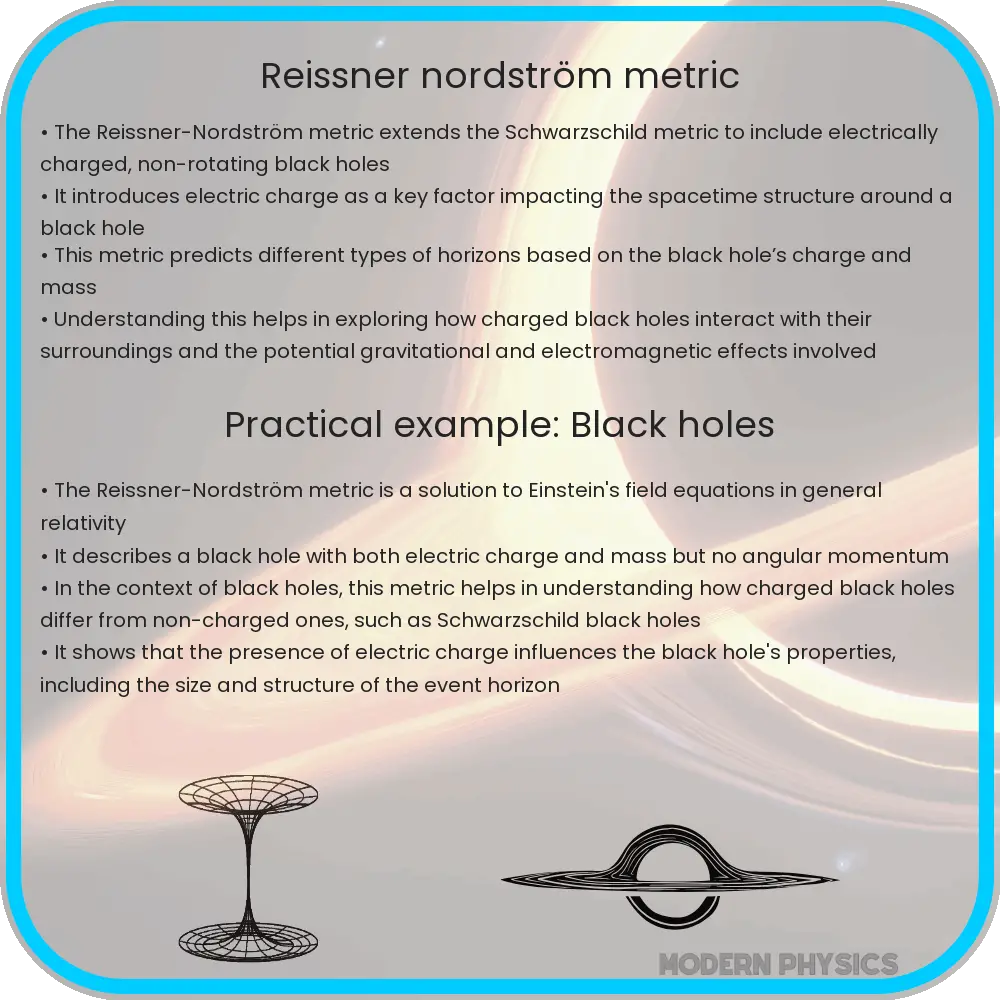Explore the Reissner-Nordström metric in general relativity: key features, implications for black holes, and theoretical debates in astrophysics.

Understanding the Reissner-Nordström Metric: Fundamentals of a Charged, Spherical Solution
The Reissner-Nordström metric is a fundamental solution in the field of general relativity, providing crucial insights into the nature of charged, spherical bodies in spacetime. This metric extends the Schwarzschild solution, which describes the gravitational field outside a non-rotating, uncharged, spherically symmetric mass, by incorporating electric charge as an additional parameter. The Reissner-Nordström metric is not only significant for its theoretical implications but also for its applications in understanding astronomical phenomena such as black holes.
Key Features of the Reissner-Nordström Metric
At its core, the Reissner-Nordström metric is characterized by two primary parameters: mass (M) and charge (Q). These factors play a pivotal role in determining the spacetime geometry around a charged, non-rotating, spherical object. The metric is expressed in natural units (c = G = 1) as:
- ds2 = -(1 – 2M/r + Q2/r2)dt2 + (1 – 2M/r + Q2/r2)-1dr2 + r2(dθ2 + sin2θ dφ2)
This equation reflects the deviation from the flat spacetime of special relativity, introduced by the mass and charge of the central object. The presence of the electric charge adds a repulsive term (Q2/r2) to the gravitational potential, altering the spacetime curvature significantly compared to the Schwarzschild solution.
Horizons in the Reissner-Nordström Geometry
A notable aspect of the Reissner-Nordström solution is the existence of horizons, similar to those found in black holes. However, the nature of these horizons differs due to the presence of charge. The solution predicts two distinct horizons:
- Event Horizon: Located at r = M + √(M2 – Q2), it acts as the point of no return for matter and light.
- Cauchy Horizon: Situated at r = M – √(M2 – Q2), this inner horizon has intriguing theoretical implications for spacetime structure and singularities.
The existence and properties of these horizons are deeply influenced by the relationship between the mass and charge of the object. When the charge equals or exceeds the mass (Q ≥ M), the nature of the spacetime changes drastically, leading to a naked singularity. This scenario challenges the cosmic censorship hypothesis and has been a subject of extensive debate in theoretical physics.
In the next section, we will delve deeper into the physical implications and applications of the Reissner-Nordström metric, exploring its role in modern astrophysics and theoretical physics.
Physical Implications and Applications of the Reissner-Nordström Metric
The Reissner-Nordström metric is not just a theoretical construct; it has practical implications in understanding various astrophysical phenomena. One of the most intriguing applications is in the study of black holes. Specifically, the metric provides a framework for analyzing the properties of charged black holes, which, though theoretically possible, are considered rare in the universe due to the natural tendency of astronomical objects to neutralize their charge.
Another significant application is in the realm of quantum gravity and string theory. The unique properties of the Reissner-Nordström black holes, particularly in the extremal case where the charge equals the mass (Q = M), provide fertile ground for testing theories of quantum gravity. This scenario results in a zero-temperature black hole, a concept crucial in the study of Hawking radiation and entropy of black holes.
Challenges and Controversies in the Reissner-Nordström Solution
Despite its theoretical elegance, the Reissner-Nordström solution is not without its challenges and controversies. One major issue is the concept of a naked singularity, which occurs when the charge exceeds the mass (Q > M). This situation violates the cosmic censorship hypothesis, which posits that singularities should always be hidden behind event horizons. The existence of naked singularities would lead to unpredictable behavior in spacetime, challenging our current understanding of physics.
Moreover, the stability of Reissner-Nordström black holes is a subject of debate. It’s hypothesized that these black holes could be unstable due to perturbations, potentially shedding their charge and transforming into Schwarzschild black holes.
Conclusion
The Reissner-Nordström metric stands as a cornerstone in the study of general relativity and astrophysics. It extends our understanding of spacetime by incorporating the effects of electric charge, offering a more comprehensive picture of gravitational fields around celestial bodies. While the practical existence of such charged black holes in nature is debatable, the theoretical insights provided by this metric are invaluable. They not only deepen our understanding of black holes and cosmic structures but also challenge and refine our theories in quantum mechanics and general relativity.
In conclusion, the Reissner-Nordström metric exemplifies the beauty and complexity of theoretical physics. It reminds us that our exploration of the universe is an ongoing journey, filled with mysteries and wonders waiting to be unraveled. As we continue to probe the depths of space, solutions like the Reissner-Nordström metric will remain essential tools in our quest to understand the cosmos.
